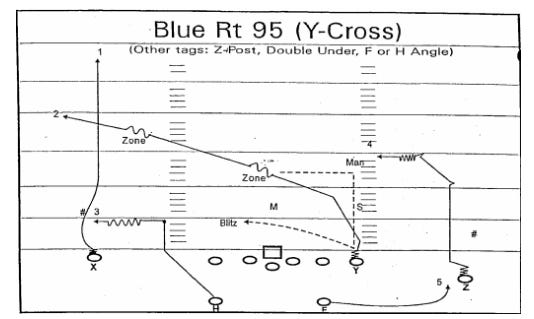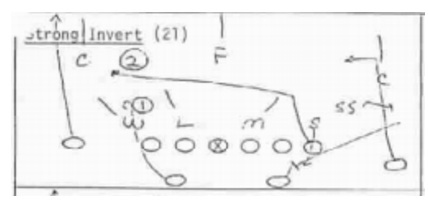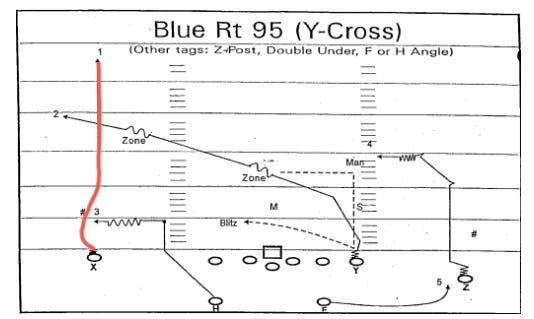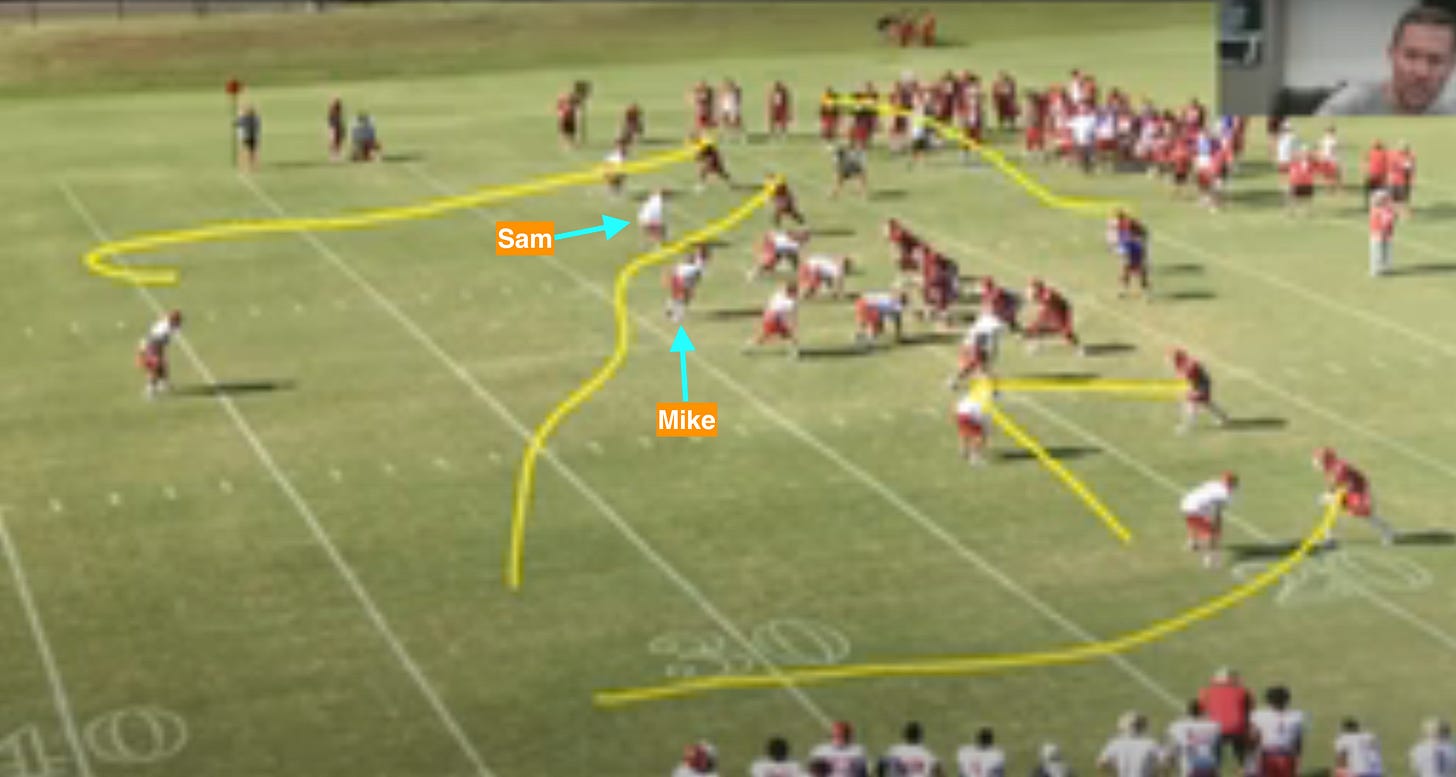LEARN A HOLGORSEN PLAY: Y Cross
The first in an offseason series breaking down some of the favorite concepts of Nebraska’s new offensive coordinator
PROGRAMMING NOTE: This is the first in an offseason series breaking down some of the favorite concepts new Nebraska offensive coordinator Dana Holgorsen has utilized at previous stops. While it’s not known exactly what style offense Holgorsen will be running at NU, he has some consistent concepts he’s carried with him throughout his play-calling career that are strong bets to be on Nebraska’s 2025 playsheet. New entries will appear sporadically throughout the offseason.
Dana Holgorsen is known as the Air Raid guy who left the Air Raid.
Before the pass-heavy scheme became ubiquitous across all levels of football and its coaching tree grew branches on branches, Holgorsen was among the first of its disciples to really marry its concepts to more “traditional” offensive ideas or incorporate elements outside the original Air Raid playbook. In his year as coordinator at Oklahoma State, he grafted heavier personnel and gap-scheme runs to the spread, shotgun-based offense that traditionally used only wide-split inside zone or draw runs as ways to keep defenses honest against the pass, and he came up with the popular pistol “diamond” formation we still see today. As head coach at West Virginia, he continued to diversify the power run game, introduced more play-action passing downfield, and began heavily utilizing a variety of pre-snap motion, including bringing the Bob Stitt touch-pass sweep to the top classification of college football:
Late in his time with WVU and early in his next job at Houston, he introduced run-pass option concepts to the offense with quarterback run elements.
Holgorsen once joked Mike Leach, one or the progenitors of the system, had him "kicked out of the Air Raid Club" for running the ball too much and straying too far from the offense’s roots.
But much of the original Air Raid offense still remains in his playbook. One such concept Holgorsen has utilized across his various stops as play-caller at Texas Tech, Oklahoma State, Houston, and West Virginia is Y Cross, an Air Raid deep passing staple.
Y Cross, at its simplest, is a weakside flood concept from a 3x2 alignment. The two-receiver side features (1) an outside vertical route and (2) a speed out/flat route from the #2, and the strongside has (3) a deep crossing route from an inside receiver, (4) an post-curl hook route on the outside, and (5) a flat release:
Nebraska ran true Y Cross just once last season — a sack vs. UCLA — but is sure to run it more often under Holgorsen. To help us better understand what’s happening when we see the Huskers run the play in 2025, let’s get into the play’s origins and history, the individual route rules and quarterback progressions, and variations that have developed on the play across football.
HISTORY
Y Cross gained notoriety within the Air Raid offense, but its actual origin was with Lavelle Edwards’ BYU teams in the 1970s, whom Hal Mumme and Leach liberally borrowed from when developing the Air Raid a decade later.
Edwards, needing a weak-side flood concept for his playbook, tweaked a popular Sid Gillman NFL play and came up with “69 H Option”:
BYU ran the play from its standard under-center, split-back offense. It had an outside receiver (the “X”) run a deep streak to try and get over top of a corner, with the back to that same side (the “H”) releasing into an underneath option route, where they could settle short in various spaces against zone coverage or run away from man coverage. From the other side of the formation, the tight end (called the “Y”) would run a deep crossing route over the middle, trying to run under the Sam linebacker and then get vertical over the top of the Mike linebacker 18 to 22 yards down the field. This led to a three-way stretch of the coverage to the weakside of the field, with a receiver in the short area-depth (the H), a receiver in the middle depth (the Y), and a receiver running deep (the X on the outside streak route).
The quarterback took a five-step drop from under center, and their first read was the H on the short option route. The play was designed to get the ball quickly to the H in space underneath the linebackers, so the ball would only go elsewhere if those linebackers overplayed down on the H. If the second-level players did overplay the H and stay closer to the line of scrimmage, the crossing Y would theoretically then be open behind them and running into the space vacated in the coverage by the X’s vertical route. The play was designed off this simple read for a quick pass and easy yardage, with multiple options for the H against all types of coverage.
But Mumme and Leach got ahold of the concept in the 1980s and made a few tweaks to create the “Y Cross” play we know today (which they called “95” in the original Air Raid playbook). First, they adapted it to also be run out of a shotgun, spread look, with the H now becoming a slot receiver instead of a split-back tailback.1 They also changed the H’s route from a true three-direction option route to a determined speed out toward the sideline, with the H running three yards straight down the field and breaking outside toward the boundary.
The most meaningful alteration, though, came to the quarterback’s progression. Leach and Mumme taught their QBs to read deep to short. Whereas BYU’s version of the play was meant to get the ball to the H tailback underneath on a quick throw, Mumme and Leach made the quarterback’s first read the outside vertical route. If that outside receiver was uncapped (meaning no safety over the top of the receiver and a one-on-one with the corner over them) and was able to win vertically against the corner, the quarterback was instructed to throw the deep route to the X. The quarterback also had the option to signal the vertical into a post route against two-high safeties, and it would still be the first read if they could beat the safety down the field. If that X was capped or unable to win vertically, the QB’s second read now became the Y on the crosser. The Y had a variety of options to find space down the field, but the aiming point was still 18 to 22 yards depth in the space theoretically vacated by the vertical. From there, the quarterback would work to the quick out from the H, and last to the backside post-curl and the flat route from the back.
Mumme and Leach changing the progression to make the two vertical routes the first options changed BYU’s “69 H Option” from a quick-hitting pass to a running back into a deep concept meant to hunt big gains. It remained a weakside flood concept and still presented answers vs. man and zone (as Edwards’ original version of the play did) but now took those advantages further down the field.
The play has largely existed in this form with the same rules since, with adaptations for the modern game and variations across the sport. It remains popular in the Air Raid tree — it’s one of Lincoln Riley’s staples — but has also spread to football writ large. Chip Kelly stole the concept and came up with his own version (which he called “Saints”) that replaced the quick out from the H with a bubble route and often paired it with play-action out of the shotgun to further mess with the linebackers. “Saints” was a huge success for Kelly with Oregon and the Philadelphia Eagles and was later adopted across football and is still popular in the NFL:
Former Kelly assistant Scott Frost utilized “Saints” frequently during his time at UCF and Nebraska. In bigger leagues, Tom Brady incorporated Y Cross into the Patriots’ system when they stole liberally from the Air Raid in the early 2010s and feasted on it with Rob Gronkowski playing the Y. Recently, Andy Reid and the Chiefs brutalized teams with variations of Y Cross and “Saints” utilizing Travis Kelce:
Many teams outside of the Air Raid tree across major-conference college football and the NFL now utilize some version of Y Cross.
If you’re interested in a longer explanation into the history of the play, this article from Wesley Ross Football goes much more in-depth and is a really great read.
RESPONSIBILITIES/READS/RULES
Let’s work through the routes as the quarterback would and go over their responsibilities and teaching points to better understand how Y Cross is run.
Read 1: The X (Vertical Route)
The quarterback’s first read on the play is the outside fly route. The QB is taught to throw this route right away if (1) the receiver gets one-on-one coverage down the field and (2) they think the receiver can “stack” the corner and win the matchup vertically down the field. Getting a one-on-one would usually entail a defensive alignment or rotation with no deep safety coverage over the top of the receiver. An example of the look to throw this route would be a single-high coverage with the lone safety shaded away and the corner pressed up, representing a difficult roll over the route for the safety and a chance to get positioning on the corner quickly at the snap. An example of a “closed” look that would eliminate this route from the progression would be a two-high safety structure or coverage or a single-high alignment with the corner playing far back off the receiver, making it difficult for the receiver to beat them down the field.
The first and main teaching point on this route for the receiver is that the X has to get off the ball as fast as possible. With the H receiver in the slot next to them breaking toward the sideline fast off the ball, the X has to vacate that space to give the H space to run into. The X can’t get caught at the line of scrimmage, be slow off the ball, or spend a bunch of time working release moves — otherwise he’ll be standing in the space where the H is running into and have eliminated both the X route and the H’s route from being open. Riley in his clinic on Y Cross said the-then OU staff only allowed the X receiver on the play to do a “speed release” against press, meaning the receiver can only beat tight pre-snap coverage by exploding up field and fighting through contact and didn’t have the option or time to try and work a release package. Likewise, the X has to release to the outside of press coverage on this play, so as to not disrupt the H’s space. Vacating that short area of the field as quickly as possible is crucial.
Second, the X has to ensure that he runs strong up the numbers vertically and doesn’t drift toward the middle of the field. Any drift away from the sideline toward the middle by the X endangers bringing the corner covering them into a position where the corner is able to defend or jump the space where the Y is running into on the crossing route. The X has to stay strong up the numbers. If the play is tagged with a post route instead of the vertical, the X can’t break to the middle on the post too early; they have to clear the area the Y is running to before they can make their break
Following the link below is a portion from a Riley Y Cross coaching clinic that shows the ideal look to throw to the X and the X’s relationship to the H’s speed out:
Click for Youtube clip of Riley discussing vertical and out relationship
The archetype of the player you want running this route is someone with (1) enough speed to get on top of the corner and (2) enough size to not be bullied back toward the middle.
Read 2: The Y (Cross)
The namesake route of the play and the most nuanced part of the concept.
If the vertical isn’t there, the quarterback’s eyes go quickly to the Y. This is less of a true defined “route” and more of an exercise in feel by the quarterback and receiver in finding the open space based on what the defense is doing. Theoretically, available actions to the Y on the cross should have an answer to almost every coverage a defense runs.
But, at the start, no matter what adjustments later, the route begins with a simple rule: “Under Sam Over Mike.”
This is the teaching point Air Raid coaches used to describe the route’s stem. The meaning is literal: The Y’s route is whatever path takes them underneath the Sam linebacker (the strongside outside linebacker, who would always be to the Y’s side because the Y sets the strength of the formation) and then get vertical enough to run over the top of the Mike linebacker (the backer in the middle of the field). This often makes the actual charting of the route resemble a squiggly line or S than the clean banana shape you see on the play sheet, but it sets specific aiming points for the receiver and quarterback to adapt to the defensive structure, setting a depth and path depending on how the defense has aligned. :
There’s some flexibility with specifically getting “over” the Mike — against certain coverages like Tampa 2 where the Mike is dropping deep down the field and with certain wide slot receiver splits it’s not really possible to get “over” the Mike. Some teams do just treat it as a path in certain situations, but “Under Sam Over Mike” is the original rule.
But after clearing the Mike, from here, the route goes into multi-option coverage read that starts with the Y making one determination: man or zone.
Keep reading with a 7-day free trial
Subscribe to Black 41 Flash Reverse to keep reading this post and get 7 days of free access to the full post archives.










